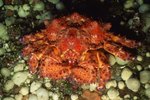
Two well-known crabs in the United States are the Dungeness crab from the West Coast and the Blue crabs hailing from the East. Both are water dwelling invertebrates as well as popular seafood delicacies, but there are many differences between these crabs, including habitat and appearance.
Habitat
The Dungeness crab was named for the Dungeness Spit by Washington state, but inhabits bays, estuaries and areas close to shore from Alaska all the way down to Monterey Bay in California. It is found in salt water at depths of 300 to 600 feet, favoring the sandy, muddy ocean floor. On the other side of the country, the Blue crab is found from Canada to the Gulf of Mexico, mainly in the Chesapeake Bay and its tidal rivers, which run the length of Maryland. The shallow waters of the Chesapeake average a depth of 40 feet with a maximum of 200 feet. Male Blue crabs, or jimmies, venture into the bay's fresher water, while females, also known as sooks, remain in saltier waters. Both genders frequent shallow water in warm weather and hibernate in deeper trenches during the winter.
Appearance
The hefty Dungeness crab averages 3 pounds at 4 to 5 years of age. Females rarely grow more than 7 inches wide and males measure up to 10 inches. The broad, round body is covered by a smooth, reddish-brown shell with a white or light orange color on the underbelly. This crab has four pairs of walking legs that are small in relation to the body, with a pair of white-tipped front claws. Their gender is determined by the size of a flap on their underside; the males' flap is longer than it is wide while the females' flap appears short and wide. The Blue crab is noticeably smaller, averaging 1 to 2 pounds and a width of 4 to 9 inches; its body twice as as wide as it is long. Along with an olive-green top shell, this crab is known for its bright blue legs. The Blue crab has only three pairs of walking legs as the fourth back legs are paddle-shaped for swimming. The apron on the underbelly of male Blue crabs is T-shaped, resembling the Washington Monument, while females' apron is broad, often compared to the Capitol building.
Reproduction and Life
Reaching sexual maturity at 3 years of age, Dungeness crabs mate a lot from May to June, though they can continue mating until the fall. Males will mate with a female shortly after she molts, or sheds her old, hard shell. Females then will store the sperm for fertilization when the eggs fully develop; she can carry 2 and a half million eggs at a time. The average life span for the Dungeness crab is between 8 and 13 years. Female Blue crabs mate only once in their lives and so the males take extra care of them during reproduction. The genders meet in the middle Bay from May through October and the male will carry the female to find a protected area for her to molt. After reproduction, he continues to carry her until her shell hardens. She is able to carry 750,000 to 2 million eggs. The blue crab reaches sexual maturity at about 1 year and lives up to 3 years.
Eat and Be Eaten
The Dungeness crab forages along the sea floor for worms, shrimp, mussels, clams and smaller crabs. When consumed by humans, it is boiled for about 20 minutes, and does not have much of a fishy taste. The Blue crab will eat practically anything, including snails, oysters, fish, bristle worms, plant matter and even juvenile blue crabs. These crabs are steamed and locally dressed with Old Bay seasoning, or the sweet meat is extracted to be used for crab cakes. Since this crab is harvested heavily, the population often faces dramatic declines.
References
Photo Credits
-
Thinkstock Images/Comstock/Getty Images
Writer Bio
Pam Smith has been writing since 2005. In addition to her work for Demand Media, her articles have been published online at CBS Local. She also wrote for the Pennsylvania Center for the Book's Literary Map while earning a Bachelor of Arts degree in English at the Pennsylvania State University. She is currently an editorial assistant for Circulation Research.




